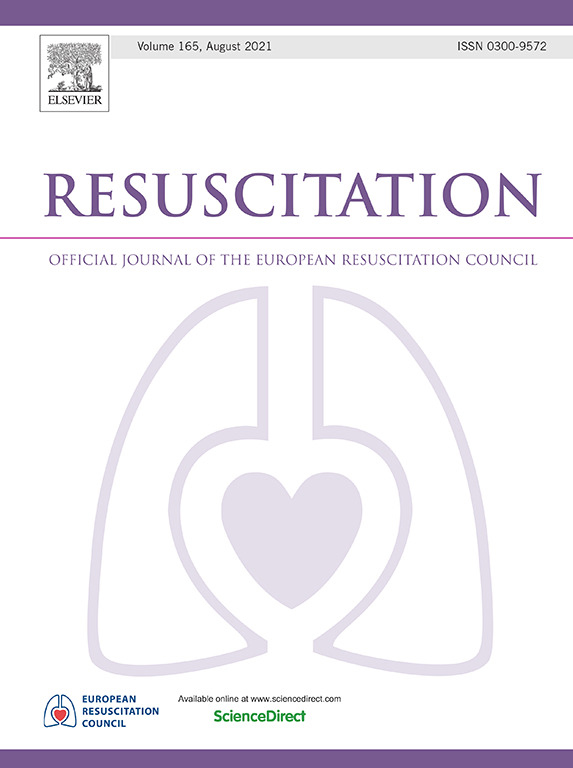Prompt dispatcher-initiated tele-CPR and facilitation of bystander’s CPR to improve out-of-hospital cardiac arrest outcomes: A prospective cohort study from Finland
IF 4.6
1区 医学
Q1 CRITICAL CARE MEDICINE
引用次数: 0
Abstract
Aim of the study
This study focused on the first link of the chain of survival by examining the dispatcher’s ability to early recognition of the OHCA patient and assessing patient outcomes.
Methods
This was a prospective cohort study that included patients who suffered OHCA in Pirkanmaa Finland in 2022. Two researchers listened to all calls separately determining key-time events of the call. All patients with confirmed recognisable OHCA during the call who had background data and audio recordings available were included.
Results
We received 451 recordings, 246 of which met the inclusion criteria, and 217 (88 %) were recognised as OHCA. The beginning of tele-CPR guidance (1 min 20 sec vs 1 min 55 sec, p = 0.002) and initiation of bystander CPR (2 min 48 sec vs 3 min 50 sec, p = 0.012) were faster in cases with shockable rhythm on EMS arrival. Every minute of delay in the dispatcher initiating tele-CPR guidance decreased the probability of shockable initial rhythm by 23 % (OR 0.76 [0.61;0.95], p = 0.018). Shockable initial rhythm was more common among patients who were alive at three months after OHCA (83 % vs 21 %, p < 0.001). In multivariable analysis, shockable initial rhythm favoured 3-month survival (OR 16.67 [5.41;52.63], p < 0.001). Overall survival at three months was 12 % (29/246), of which 90 % (26/29) had a Cerebral Performance Category of 1–2.
Conclusion
Quick tele-CPR guidance may be related to/ associated with improving the chances for shockable initial rhythm, thus further improving the chances for long-term survival.
迅速调度员发起的远程心肺复苏术和促进旁观者的心肺复苏术改善院外心脏骤停结果:芬兰的一项前瞻性队列研究。
研究目的:本研究通过检查调度员早期识别OHCA患者和评估患者预后的能力,重点关注生存链的第一个环节。方法:这是一项前瞻性队列研究,纳入了2022年在芬兰Pirkanmaa遭受OHCA的患者。两名研究人员分别监听所有呼叫,确定呼叫的关键时间事件。所有在通话期间确认有可识别的OHCA的患者都包括在内,他们有背景数据和录音。结果:共收到451份记录,其中246份符合纳入标准,217份(88%)为OHCA。在EMS到达时具有震荡性心律的患者中,远程CPR引导(1分20秒vs 1分55秒,p=0.002)和旁观者CPR开始(2分48秒vs 3分50秒,p=0.012)更快。调度员每延迟一分钟启动远程cpr指导,可使休克性初始心律的概率降低23% (OR 0.76 [0.61;0.95], p=0.018)。在OHCA后3个月存活的患者中,可休克性初始心律更为常见(83% vs 21%)。结论:快速远程cpr指导与提高可休克性初始心律的机会有关,从而进一步提高长期生存的机会。
本文章由计算机程序翻译,如有差异,请以英文原文为准。
求助全文
约1分钟内获得全文
求助全文
来源期刊

Resuscitation
医学-急救医学
CiteScore
12.00
自引率
18.50%
发文量
556
审稿时长
21 days
期刊介绍:
Resuscitation is a monthly international and interdisciplinary medical journal. The papers published deal with the aetiology, pathophysiology and prevention of cardiac arrest, resuscitation training, clinical resuscitation, and experimental resuscitation research, although papers relating to animal studies will be published only if they are of exceptional interest and related directly to clinical cardiopulmonary resuscitation. Papers relating to trauma are published occasionally but the majority of these concern traumatic cardiac arrest.
 求助内容:
求助内容: 应助结果提醒方式:
应助结果提醒方式:


